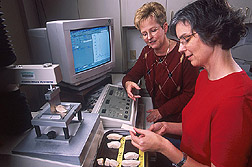This page has been archived and is being provided for reference purposes only. The page is no longer being updated, and therefore, links on the page may be invalid.
|
Bookmark this page for the latest news about ARS research.
Read the magazine story to find out more. |
ARS Aims for Tender ChickenBy Sharon DurhamFebruary 19, 2002 The Agricultural Research Service’s sensory evaluation research helps produce tender, juicy chickens. Getting a tender chicken to the supermarket may seem simple, but a lot of work goes into it. A chicken's breeding, diet, and disease-control regimen all play a part in providing the best possible bird in a cost-efficient manner. ARS food scientist Brenda Lyon’s studies in the Quality Assessment Research Unit in Athens, Ga., focus on how changes in chicken production affect the taste, texture and other sensory attributes of the meat. For example, changing a bird’s feed, or deciding to package it whole or in pieces, could affect how desirable the meat is for consumers. New, more convenient marketing and packaging of chicken parts have allowed the poultry industry to meet consumer preferences. But cutting the chicken into premium-priced parts can present a problem. Chilling allows time for the muscle fibers to go through natural biochemical processes that make muscle tender. If quickly cut chicken parts don’t have enough time to chill, the meat will be tougher. Of course, consumers want tender chicken breasts, legs and other parts. To find out the effect of different processing methods on chicken meat, sensory evaluation fills the bill. Instruments can measure some characteristics adequately--for example, the amount of force needed to cut through a piece of meat. However, human evaluations are necessary to determine aroma, taste, texture and sound, all of which are quality characteristics perceived by the senses. Sensory characteristics give clues to changes in product components that ultimately are responsible for what sensory cues influence consumer acceptance. This can lead to more efficient, economic production methods for the poultry industry and help processors and product developers provide better, more consistent items to the consumer. A more detailed story on sensory evaluation research appears in the February issue of Agricultural Research magazine. ARS is the U.S. Department of Agriculture’s chief scientific research agency. |

